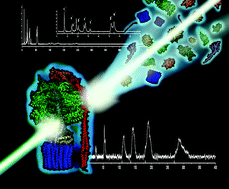ATP synthases: cellular nanomotors characterized by LILBIDmass spectrometry
Abstract

- This article is part of the themed collection: Advances in mass spectrometry for biological science
Maintenance work is planned for Wednesday 1st May 2024 from 9:00am to 11:00am (BST).
During this time, the performance of our website may be affected - searches may run slowly and some pages may be temporarily unavailable. If this happens, please try refreshing your web browser or try waiting two to three minutes before trying again.
We apologise for any inconvenience this might cause and thank you for your patience.
* Corresponding authors
a
Institute for Physical and Theoretical Chemistry, Cluster of Excellence Frankfurt “Macromolecular Complexes”, Centre for Membrane Proteomics, Goethe-Universität, Max-von-Laue Str. 7, 60438 Frankfurt am Main, Germany
E-mail:
brutschy@chemie.uni-frankfurt.de
b
Department of Structural Biology, Max-Planck Institute of Biophysics, Max-von-Laue-Str. 3, 60438 Frankfurt am Main, Germany
E-mail:
thomas.meier@biophys.mpg.de
c Department of Pharmacology and Systems Therapeutics, Mount Sinai School of Medicine, 1 Gustave L. Levy Place, New York 10029, USA
d Department of Chemistry, Physical and Theoretical Chemistry Laboratory, South Parks Road, Oxford OX1 3QZ, UK
e Molecular Bioenergetics, Medical School, Goethe-Universität Frankfurt, Theodor-Stern-Kai 7, Haus 26, D-60590 Frankfurt am Main, Germany

 Please wait while we load your content...
Something went wrong. Try again?
Please wait while we load your content...
Something went wrong. Try again?
J. Hoffmann, L. Sokolova, L. Preiss, D. B. Hicks, T. A. Krulwich, N. Morgner, I. Wittig, H. Schägger, T. Meier and B. Brutschy, Phys. Chem. Chem. Phys., 2010, 12, 13375 DOI: 10.1039/C0CP00733A
To request permission to reproduce material from this article, please go to the Copyright Clearance Center request page.
If you are an author contributing to an RSC publication, you do not need to request permission provided correct acknowledgement is given.
If you are the author of this article, you do not need to request permission to reproduce figures and diagrams provided correct acknowledgement is given. If you want to reproduce the whole article in a third-party publication (excluding your thesis/dissertation for which permission is not required) please go to the Copyright Clearance Center request page.
Read more about how to correctly acknowledge RSC content.
 Fetching data from CrossRef.
Fetching data from CrossRef.
This may take some time to load.
Loading related content
